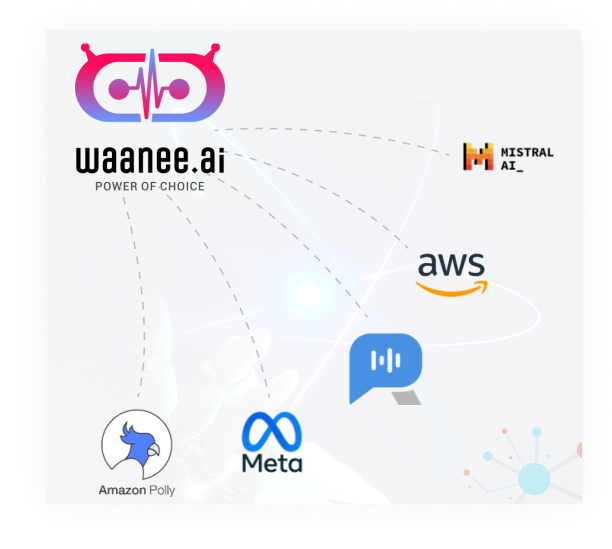
-
Waanee AI Labs
View All »

Get The Latest
Will AI Replace Call Center Agents? The Truth About Virtual Assistants and Human Collaboration
Read More »Transforming Contact Centers with Waanee AI's Agentic Framework
Read More »Generative AI Voice Bots: Strategic Sweet Spots for Organizational Scale
Read More » - Blog
Increasing customer adaptation towards conversation with intelligent voice bots
Posted by Vishal Vanwari, on 17 Sep, 2024 06:48 AM

In an era where digital transformation is reshaping customer service landscapes, intelligent voice bots have emerged as powerful tools for businesses to enhance customer experience and streamline operations. However, the success of these AI-powered assistants hinges on one into strategies, it’s essential to recognize why some customers might be hesitant tocrucial factor: customer adaptation. This blog post explores effective strategies to increase customer comfort and willingness to engage with intelligent voice bots, ultimately leading to improved satisfaction and efficiency.
Understanding the Hesitation
Before diving interact with voice bots:
- Fear of misunderstanding or being misunderstood
- Preference for human interaction
- Previous negative experiences with less advanced systems
- Concerns about data privacy and security
Addressing these concerns is the first step in fostering greater acceptance of voice bot technology.
Strategies for Increasing Customer Adaptation
- Prioritize Natural Language Processing (NLP)
Invest in advanced NLP capabilities to ensure your voice bots can understand and respond to a wide range of natural language inputs. The more human-like the interaction, the more comfortable customers will feel.
- Offer a Seamless Handoff to Human Agents
Implement a system where customers can easily switch to a human agent if needed. This safety net can significantly reduce anxiety about using voice bots, as customers know help is readily available if the bot can’t resolve their issue.
- Be Transparent About AI Usage
Clearly communicate to customers when they’re interacting with an AI-powered voice bot. Transparency builds trust and sets appropriate expectations for the interaction.
- Personalize the Experience
Utilize customer data (with proper consent) to personalize interactions. When voice bots can reference past interactions or preferences, it creates a more engaging and efficient experience.
- Continuously Improve and Update
Regularly analyze customer interactions to identify areas for improvement. Use this data to update and refine your voice bot’s capabilities, expanding its knowledge base and improving its conversation skills.
- Provide Multiple Interaction Channels
While promoting voice bot usage, continue to offer alternative channels for customer support. This multi-channel approach allows customers to choose their preferred method of communication.
- Gamify the Experience
Consider incorporating gamification elements into voice bot interactions. This could include rewards for successful problem resolution or completing certain tasks through the bot, encouraging repeated use and familiarity.
- Educate Customers
Create short, engaging tutorials or guides on how to effectively use your voice bot. Highlight its capabilities and the benefits of using this technology, such as 24/7 availability and quick response times.
- Start with Simple Tasks
Initially, direct customers to use voice bots for simpler tasks where success rates are high. As they become more comfortable, gradually introduce more complex interactions.
- Gather and Act on Feedback
Actively solicit feedback from customers about their voice bot experiences. Use this information to make improvements and show customers that their input is valued.
Overcoming Common Challenges
Privacy Concerns
Address data privacy head-on by clearly communicating your company’s data protection policies. Explain how customer information is used and protected during voice bot interactions.
Language and Accent Barriers
Invest in multilingual capabilities and accent recognition to ensure your voice bot can serve a diverse customer base effectively.
Technical Issues
Ensure your voice bot system is robust and can handle high call volumes. Have contingency plans in place for system downtimes to maintain customer trust.
The Future of Customer Service
As AI technology continues to advance, the line between human and AI interactions will become increasingly blurred. By implementing these strategies and focusing on creating positive experiences, businesses can help customers embrace the benefits of intelligent voice bots.
Remember, the goal isn’t to replace human interaction entirely, but to complement and enhance it. Voice bots can handle routine inquiries efficiently, freeing up human agents to tackle more complex issues that require empathy and nuanced understanding.
In conclusion, increasing customer adaptation to intelligent voice bots is a journey that requires patience, continuous improvement, and a deep commitment to customer satisfaction. By addressing concerns, showcasing benefits, and consistently delivering value, businesses can help customers feel more comfortable and confident in their interactions with AI-powered voice assistants. As this technology becomes more prevalent, those who successfully navigate this transition will be well-positioned to provide superior customer service in an increasingly digital world.
READ ALSO...
Will AI Replace Call Center Agents? The Truth About Virtual Assistants and Human Collaboration
19 May, 2025 11:30 AM
Transforming Contact Centers with Waanee AI's Agentic Framework
25 Feb, 2025 01:52 PM
Generative AI Voice Bots: Strategic Sweet Spots for Organizational Scale
28 Dec, 2024 08:51 AM
Revolutionize CX
with AI power
Delivers personalized interactions and immediate, data-driven solutions powered by AI, transforming customer experiences.

We use cookies!
We use cookies to ensure that we give you the best experience on our website.
By continuing to use this site, you accept our use of cookies. Learn more
 Recruit Industries Agents
Recruit Industries Agents Build Your Agent
Build Your Agent Improve Self Service
Improve Self Service Employee Experience
Employee Experience Sales and Cross Sales
Sales and Cross Sales Calling Script
Calling Script Integration & APIs
Integration & APIs Auto Summarization
Auto Summarization Conversational Intelligence
Conversational Intelligence Sentiment Analytics
Sentiment Analytics Auto QA
Auto QA Net Promoter Score
Net Promoter Score